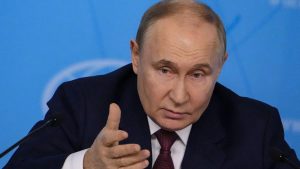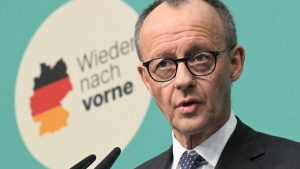
We’ve known for some time by examining history that it’s much easier to start a war than it is to stop one. And I suspect the Russia-Ukraine war will prove to be no different. A ceasefire may well be had but this will occur in spite of Trump’s loud insistence that a ceasefire be reached by both parties not because of it, and him.
Let’s start though with the larger context – that is Trump as the initiator of the ceasefire efforts. I was interested in a sort of mea culpa moment expressed by colleague, Stephen Walt. Stephen is the Robert and Renée Belfer professor of international relations at Harvard University and is also a columnist at Foreign Policy (FP). In a recent piece in FP entitled, “What I Got Wrong About Trump’s Second Term”, he zeros in on the fact that it is Trump pushing the ceasefire effort. As he admits:
“That said, there’s no question that I got some important things wrong.”
“I underestimated Trump’s hostility to our principal democratic allies. It was obvious that he thought our NATO partners were overly reliant on U.S. protection (a view shared by all recent U.S. presidents), but it’s now clear that he’s actively and deeply hostile to the democratic principles that these states embody and is openly encouraging illiberal forces within them. As I wrote a couple of weeks ago, the administration’s embrace of the European far right is an attempt to promote a form of regime change throughout Europe—in effect, to MAGA-fy it—and to destroy the European Union as a meaningful political institution. I was aware of Trump’s affinity for illiberal leaders like Hungarian Prime Minister Viktor Orban, and I knew people like Steve Bannon were trying to build a transnational coalition of far-right movements, but I didn’t take those forces seriously enough. … although there was every reason to think that Trump would push for a peace deal and eventually reduce U.S. support for Ukraine, I did not expect him to embrace Russian President Vladimir Putin’s position with such enthusiasm, accuse Ukraine of starting the war, or openly attack Ukrainian President Volodymyr Zelensky in public. There may, in fact, be some strategic rationale for what Trump is doing—i.e., he may genuinely believe that the only way to stop the war and eventually drive a wedge between Russia and China is to give Putin everything he wants—but that doesn’t mean this approach will work as intended. It also ignores the long-term impact that this behavior will have on the United States’ standing and image. … Moreover, Trump isn’t breaking these rules because the United States is facing a grave national emergency (which would make it easier for other states to give Washington a temporary pass); he’s trying to blow up the whole order because he thinks the United States will be better off in a world where autocracy is ascendant and leaders do whatever they want. I freely admit that transforming the United States from a defender of international order to a malevolent rogue state was not on my bingo card.”
Well, indeed we were witness to Trump, along with his Vice Presidential puppet, J.D. Vance throwing Ukraine, or at least Volodymyr Zelenskyy ‘under the bus’. Now Zelenskyy may not have handled that strangely open White House meeting with Trump and Vance quite as adroitly as he might have but he did come back with Ukraine accepting Trump’s ceasefire agreement. As Alexandra Sharp pointed out earlier in the week in a FP World Brief:
“The United States agreed to immediately lift its pause on all military aid and intelligence-sharing to Kyiv on Tuesday following talks with senior Ukrainian officials in Jeddah, Saudi Arabia. In turn, Ukraine expressed willingness to enact a 30-day cease-fire with Russia and enter immediate negotiations to establish an “enduring and sustainable” end to the conflict—so long as Moscow agrees to do the same.”
And as she pointed out, Zelenskyy wisely praised Trump’s efforts:
“Zelensky praised Tuesday’s talks and expressed gratitude for the Trump administration, highlighting the ways that the United States’ plan addressed Kyiv’s initial suggestions. Trump also celebrated the Jeddah meeting, saying, “Hopefully President Putin will agree to that also and we can get this show on the road.” The Kremlin has not yet responded to the cease-fire proposal. But Trump said that he expects to speak with Putin this week, adding, “It takes two to tango.””
Now it seems that Putin has seen fit to walk a kinda tightrope on the US ceasefire proposal. An outright rejection would for sure lead Trump to in some manner condemn Putin, probably enhance sanctions on Russia, and likely ‘throw a bone to Ukraine’ including presumably enhanced military support to pressure a change from Putin. So rather than face any of that immediately we have Putin expressing a kinda tepid yes in a recent press conference but adding a significant number of questions and qualifications.
As the Italian think tank, ISPI pointed out in an insightful piece titled, ‘Putin and the ‘No’ to the Truce’:
“Putin is not saying ‘no’ to Washington and Kiev’s ceasefire proposal, but he is not saying yes either. And he is laying out his own conditions , saying he needs “further clarification.” The Russian president, 48 hours into his wait since announcing his proposal for a month-long interim truce two days ago in Jeddah , said any ceasefire must lead to “a final solution” to the conflict that addresses its “root causes.” “The idea itself is good and we support it unconditionally,” he said, “but there are issues that we need to discuss, and I think we need to discuss them with our American colleagues and partners,” adding that otherwise Ukrainian forces “will be given the opportunity to withdraw, regroup and rearm,” just as the Russian army advances into the Kursk region , the Russian salient captured by Kiev’s troops.”
“The preconditions set by Putin for a ceasefire essentially coincide with Moscow’s war objectives: recognition of Moscow’s annexation of four partially occupied southeastern regions ( Kherson, Zaporizhzhia, Donetsk, Luhansk ) and the Crimean peninsula; Kiev’s commitment to never join NATO; and the organization of new elections that will lead to the replacement of President Volodymyr Zelensky. Russia is also pushing for a NATO retreat, whose expansion to the east, according to the Kremlin’s narrative, would have ‘forced’ Moscow to order the invasion of Ukraine in 2022. In fact – according to several observers – Putin’s interlocutory response is due to two needs: on the one hand, he does not want to be accused of obstructing the agreement to which Trump has formally adhered, on the other, he knows that at this moment the war is turning in his favor and he does not intend to give up without obtaining something in return .”
Now it is the case that Zelenskyy has doubts about the ceasefire effort. First he is dealing with Russia but more pertinently Zelenskyy remains insistent that any agreement that follows the short ceasefire must provide security guarantees for Ukraine. But for the moment the focus is on Russia. And as Mary Ilyushina and Sammy Westfall of the Washington Post noted:
“Putin said Thursday he supports in principle the idea of a 30-day ceasefire — proposed by the United States and to which Ukraine has agreed — but noted that its implementation raises many questions, particularly regarding verification across a long front line. Such a tactic could allow Russia to engage in protracted negotiations without immediately rejecting an offer.”
“Putin also said the 30-day reprieve could be used by Ukraine to regroup and rearm, hinting that he would seek to impose his own conditions on the framework of the pause, such as a halt to Western weapons supplies or a ban on mobilization.”
Meanwhile, the G7 foreign ministers gathered in Canada and pressed Russia to accept the current ceasefire proposal. In the Statement issued at the end of the meeting the foreign ministers declared:
“G7 members reaffirmed their unwavering support for Ukraine in defending its territorial integrity and right to exist, and its freedom, sovereignty and independence.
They welcomed ongoing efforts to achieve a ceasefire, and in particular the meeting on March 11 between the U.S. and Ukraine in the Kingdom of Saudi Arabia. G7 members applauded Ukraine’s commitment to an immediate ceasefire, which is an essential step towards a comprehensive, just and lasting peace in line with the Charter of the United Nations.
G7 members called for Russia to reciprocate by agreeing to a ceasefire on equal terms and implementing it fully. They discussed imposing further costs on Russia in case such a ceasefire is not agreed, including through further sanctions, caps on oil prices, as well as additional support for Ukraine, and other means. This includes the use of extraordinary revenues stemming from immobilized Russian Sovereign Assets. G7 members underlined the importance of confidence-building measures under a ceasefire including the release of prisoners of war and detainees—both military and civilian—and the return of Ukrainian children.”
In addition, UK Prime Minister Starmer added further pressure. As described in the NYTimes:
“On Saturday [March 15th], Mr. Starmer convened a video conference with 30 leaders, from Europe, NATO, Canada, Ukraine, Australia and New Zealand, to muster support for his coalition, which Britain is spearheading with France. He said military officials would meet again on Thursday to begin an “operational phase,” though he did not give details about the mission of the force, nor did he announce that any other countries had committed troops to it.
“I’ve indicated a willingness for the United Kingdom to play a leading role in this,” Mr. Starmer said at a news conference after the meeting. “If necessary, that would be troops on the ground and planes in the sky.”
And, finally, another piece of the European effort to support Ukraine appears to be falling in place. There now appears to be agreement on a new German government led by Friedrich Merz. As described in the NYTimes:
“Friedrich Merz, the likely next chancellor of Germany, announced on Friday that he had secured the votes to allow for extensive new government spending, including for defense, clearing the way for a stunning turnabout in German strategic and fiscal policy before he even takes office.”
“The measures would lift Germany’s hallowed limits on government borrowing as they apply to military spending. It would exempt all spending on defense above 1 percent of the nation’s gross domestic product from those limits, and it would define “defense” broadly to include intelligence spending, information security and more.
Effectively, that would allow Germany to spend as much as it can feasibly borrow to rebuild its military.”
The ‘yes but no’ by Putin may not have long to live. Secretary of State, Marco Rubio made it clear following the foreign ministers meeting, as described in the FT that the administration would soon examine the state of the ceasefire proposal and the positions of the two parties:
“Rubio, who has previously indicated Kyiv would have to make territorial concessions, on Friday signalled Moscow would also have to do so. “I’ve never heard President Trump say that Russia has a right to take all of Ukraine and do whatever they want there,” he said. He added Trump’s national security team will convene this weekend after the president’s envoy Steve Witkoff returns from Moscow to examine the Russian position.”
Ending wars is not easy. And the end is not yet in sight, seemingly. Still, pressure appears to remain on.
This Post first appeared on my Substack, Alan’s Newsletter: https://globalsummitryproject.substack.com/p/stopping-the-war-or-maybe-not-yet
Image Credit: BBC

